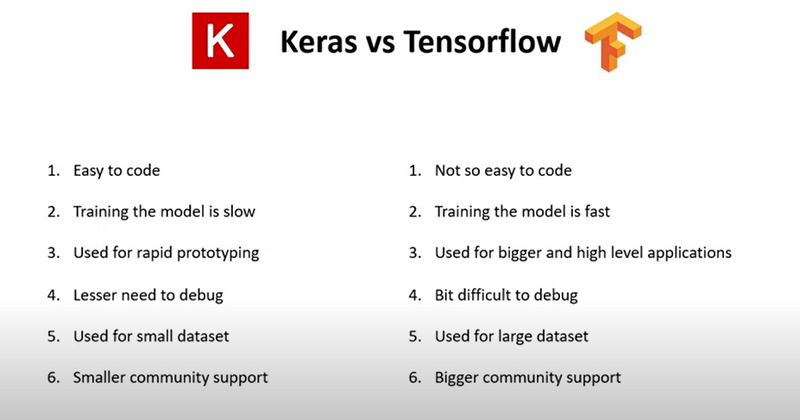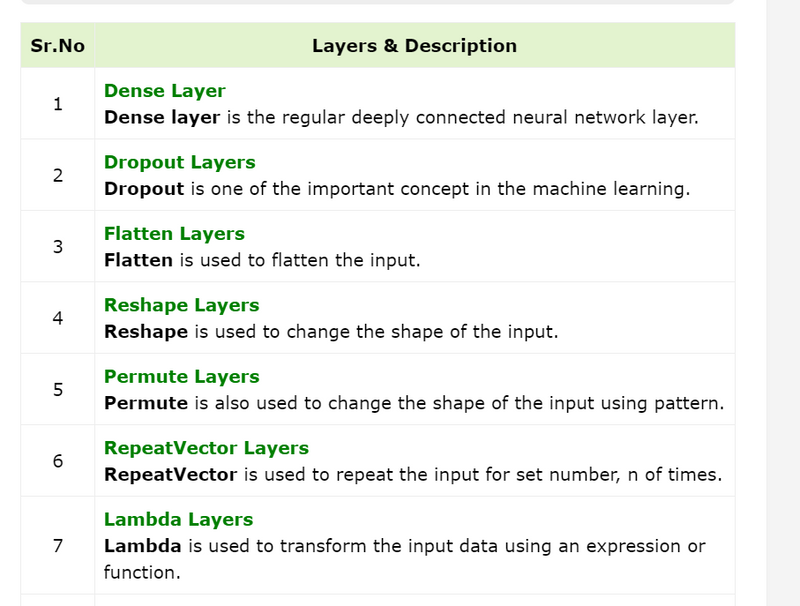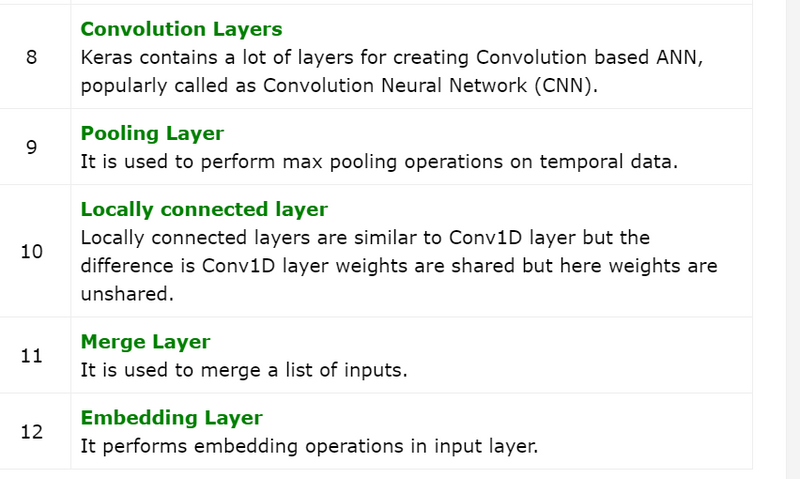What are the minimum requirement in keras layer
What are the minimum requirement in keras layer
Keras layer requires below minimum details to create a complete layer.
Shape of the input data
Number of neurons / units in the layer
Initializers
Regularizers
Constraints
Activations
Let us understand the basic concept in the next chapter. Before understanding the basic concept, let us create a simple Keras layer using Sequential model API to get the idea of how Keras model and layer works.
from keras.models import Sequential
from keras.layers import Activation, Dense
from keras import initializers
from keras import regularizers
from keras import constraints
model = Sequential()
model.add(Dense(32, input_shape=(16,), kernel_initializer = 'he_uniform',
kernel_regularizer = None, kernel_constraint = 'MaxNorm', activation = 'relu'))
model.add(Dense(16, activation = 'relu'))
model.add(Dense(8))
where,
Line 1-5 imports the necessary modules.
Line 7 creates a new model using Sequential API.
Line 9 creates a new Dense layer and add it into the model. Dense is an entry level layer provided by Keras, which accepts the number of neurons or units (32) as its required parameter. If the layer is first layer, then we need to provide Input Shape, (16,) as well. Otherwise, the output of the previous layer will be used as input of the next layer. All other parameters are optional.
First parameter represents the number of units (neurons).
input_shape represent the shape of input data.
kernel_initializer represent initializer to be used. he_uniform function is set as value.
kernel_regularizer represent regularizer to be used. None is set as value.
kernel_constraint represent constraint to be used. MaxNorm function is set as value.
activation represent activation to be used. relu function is set as value.
Line 10 creates second Dense layer with 16 units and set relu as the activation function.
Line 11 creates final Dense layer with 8 units.
Basic Concept of Layers
Input shape
In machine learning, all type of input data like text, images or videos will be first converted into array of numbers and then feed into the algorithm. Input numbers may be single dimensional array, two dimensional array (matrix) or multi-dimensional array. We can specify the dimensional information using shape, a tuple of integers. For example, (4,2) represent matrix with four rows and two columns.
>>> import numpy as np
>>> shape = (4, 2)
>>> input = np.zeros(shape)
>>> print(input)
[
[0. 0.]
[0. 0.]
[0. 0.]
[0. 0.]
]
>>>
Similarly, (3,4,2) three dimensional matrix having three collections of 4x2 matrix (two rows and four columns).
>>> import numpy as np
>>> shape = (3, 4, 2)
>>> input = np.zeros(shape)
>>> print(input)
[
[[0. 0.] [0. 0.] [0. 0.] [0. 0.]]
[[0. 0.] [0. 0.] [0. 0.] [0. 0.]]
[[0. 0.] [0. 0.] [0. 0.] [0. 0.]]
]
>>>
To create the first layer of the model (or input layer of the model), shape of the input data should be specified.
Initializers
In Machine Learning, weight will be assigned to all input data. Initializers module provides different functions to set these initial weight. Some of the Keras Initializer function are as follows −
Zeros
Generates 0 for all input data.
from keras.models import Sequential
from keras.layers import Activation, Dense
from keras import initializers
my_init = initializers.Zeros()
model = Sequential()
model.add(Dense(512, activation = 'relu', input_shape = (784,),
kernel_initializer = my_init))
Where, kernel_initializer represent the initializer for kernel of the model.
Ones
Generates 1 for all input data.
from keras.models import Sequential
from keras.layers import Activation, Dense
from keras import initializers
my_init = initializers.Ones()
model.add(Dense(512, activation = 'relu', input_shape = (784,),
kernel_initializer = my_init))
Constant
Generates a constant value (say, 5) specified by the user for all input data.
from keras.models import Sequential
from keras.layers import Activation, Dense
from keras import initializers
my_init = initializers.Constant(value = 0) model.add(
Dense(512, activation = 'relu', input_shape = (784,), kernel_initializer = my_init)
)
where, value represent the constant value
RandomNormal
Generates value using normal distribution of input data.
from keras.models import Sequential
from keras.layers import Activation, Dense
from keras import initializers
my_init = initializers.RandomNormal(mean=0.0,
stddev = 0.05, seed = None)
model.add(Dense(512, activation = 'relu', input_shape = (784,),
kernel_initializer = my_init))
where,
mean represent the mean of the random values to generate
stddev represent the standard deviation of the random values to generate
seed represent the values to generate random number
RandomUniform
Generates value using uniform distribution of input data.
from keras import initializers
my_init = initializers.RandomUniform(minval = -0.05, maxval = 0.05, seed = None)
model.add(Dense(512, activation = 'relu', input_shape = (784,),
kernel_initializer = my_init))
where,
minval represent the lower bound of the random values to generate
maxval represent the upper bound of the random values to generate
TruncatedNormal
Generates value using truncated normal distribution of input data.
from keras.models import Sequential
from keras.layers import Activation, Dense
from keras import initializers
my_init = initializers.TruncatedNormal(mean = 0.0, stddev = 0.05, seed = None
model.add(Dense(512, activation = 'relu', input_shape = (784,),
kernel_initializer = my_init))
VarianceScaling
Generates value based on the input shape and output shape of the layer along with the specified scale.
from keras.models import Sequential
from keras.layers import Activation, Dense
from keras import initializers
my_init = initializers.VarianceScaling(
scale = 1.0, mode = 'fan_in', distribution = 'normal', seed = None)
model.add(Dense(512, activation = 'relu', input_shape = (784,),
skernel_initializer = my_init))
where,
scale represent the scaling factor
mode represent any one of fan_in, fan_out and fan_avg values
distribution represent either of normal or uniform
VarianceScaling
It finds the stddev value for normal distribution using below formula and then find the weights using normal distribution,
stddev = sqrt(scale / n)
where n represent,
number of input units for mode = fan_in
number of out units for mode = fan_out
average number of input and output units for mode = fan_avg
Similarly, it finds the limit for uniform distribution using below formula and then find the weights using uniform distribution,
limit = sqrt(3 * scale / n)
lecun_normal
Generates value using lecun normal distribution of input data.
from keras.models import Sequential
from keras.layers import Activation, Dense
from keras import initializers
my_init = initializers.RandomUniform(minval = -0.05, maxval = 0.05, seed = None)
model.add(Dense(512, activation = 'relu', input_shape = (784,),
kernel_initializer = my_init))
It finds the stddev using the below formula and then apply normal distribution
stddev = sqrt(1 / fan_in)
where, fan_in represent the number of input units.
lecun_uniform
Generates value using lecun uniform distribution of input data.
from keras.models import Sequential
from keras.layers import Activation, Dense
from keras import initializers
my_init = initializers.lecun_uniform(seed = None)
model.add(Dense(512, activation = 'relu', input_shape = (784,),
kernel_initializer = my_init))
It finds the limit using the below formula and then apply uniform distribution
limit = sqrt(3 / fan_in)
where,
fan_in represents the number of input units
fan_out represents the number of output units
glorot_normal
Generates value using glorot normal distribution of input data.
from keras.models import Sequential
from keras.layers import Activation, Dense
from keras import initializers
my_init = initializers.glorot_normal(seed=None) model.add(
Dense(512, activation = 'relu', input_shape = (784,), kernel_initializer = my_init)
)
It finds the stddev using the below formula and then apply normal distribution
stddev = sqrt(2 / (fan_in + fan_out))
where,
fan_in represents the number of input units
fan_out represents the number of output units
glorot_uniform
Generates value using glorot uniform distribution of input data.
from keras.models import Sequential
from keras.layers import Activation, Dense
from keras import initializers
my_init = initializers.glorot_uniform(seed = None)
model.add(Dense(512, activation = 'relu', input_shape = (784,),
kernel_initializer = my_init))
It finds the limit using the below formula and then apply uniform distribution
limit = sqrt(6 / (fan_in + fan_out))
where,
fan_in represent the number of input units.
fan_out represents the number of output units
he_normal
Generates value using he normal distribution of input data.
from keras.models import Sequential
from keras.layers import Activation, Dense
from keras import initializers
my_init = initializers.RandomUniform(minval = -0.05, maxval = 0.05, seed = None)
model.add(Dense(512, activation = 'relu', input_shape = (784,),
kernel_initializer = my_init))
It finds the stddev using the below formula and then apply normal distribution.
stddev = sqrt(2 / fan_in)
where, fan_in represent the number of input units.
he_uniform
Generates value using he uniform distribution of input data.
from keras.models import Sequential
from keras.layers import Activation, Dense
from keras import initializers
my_init = initializers.he_normal(seed = None)
model.add(Dense(512, activation = 'relu', input_shape = (784,),
kernel_initializer = my_init))
It finds the limit using the below formula and then apply uniform distribution.
limit = sqrt(6 / fan_in)
where, fan_in represent the number of input units.
Orthogonal
Generates a random orthogonal matrix.
from keras.models import Sequential
from keras.layers import Activation, Dense
from keras import initializers
my_init = initializers.Orthogonal(gain = 1.0, seed = None)
model.add(Dense(512, activation = 'relu', input_shape = (784,),
kernel_initializer = my_init))
where, gain represent the multiplication factor of the matrix.
Identity
Generates identity matrix.
from keras.models import Sequential
from keras.layers import Activation, Dense
from keras import initializers
my_init = initializers.Identity(gain = 1.0) model.add(
Dense(512, activation = 'relu', input_shape = (784,), kernel_initializer = my_init)
)
Constraints
In machine learning, a constraint will be set on the parameter (weight) during optimization phase. <>Constraints module provides different functions to set the constraint on the layer. Some of the constraint functions are as follows.
NonNeg
Constrains weights to be non-negative.
from keras.models import Sequential
from keras.layers import Activation, Dense
from keras import initializers
my_init = initializers.Identity(gain = 1.0) model.add(
Dense(512, activation = 'relu', input_shape = (784,),
kernel_initializer = my_init)
)
where, kernel_constraint represent the constraint to be used in the layer.
UnitNorm
Constrains weights to be unit norm.
from keras.models import Sequential
from keras.layers import Activation, Dense
from keras import constraints
my_constrain = constraints.UnitNorm(axis = 0)
model = Sequential()
model.add(Dense(512, activation = 'relu', input_shape = (784,),
kernel_constraint = my_constrain))
MaxNorm
Constrains weight to norm less than or equals to the given value.
from keras.models import Sequential
from keras.layers import Activation, Dense
from keras import constraints
my_constrain = constraints.MaxNorm(max_value = 2, axis = 0)
model = Sequential()
model.add(Dense(512, activation = 'relu', input_shape = (784,),
kernel_constraint = my_constrain))
where,
max_value represent the upper bound
axis represent the dimension in which the constraint to be applied. e.g. in Shape (2,3,4) axis 0 denotes first dimension, 1 denotes second dimension and 2 denotes third dimension
MinMaxNorm
Constrains weights to be norm between specified minimum and maximum values.
from keras.models import Sequential
from keras.layers import Activation, Dense
from keras import constraints
my_constrain = constraints.MinMaxNorm(min_value = 0.0, max_value = 1.0, rate = 1.0, axis = 0)
model = Sequential()
model.add(Dense(512, activation = 'relu', input_shape = (784,),
kernel_constraint = my_constrain))
where, rate represent the rate at which the weight constrain is applied.
Regularizers
In machine learning, regularizers are used in the optimization phase. It applies some penalties on the layer parameter during optimization. Keras regularization module provides below functions to set penalties on the layer. Regularization applies per-layer basis only.
L1 Regularizer
It provides L1 based regularization.
from keras.models import Sequential
from keras.layers import Activation, Dense
from keras import regularizers
my_regularizer = regularizers.l1(0.)
model = Sequential()
model.add(Dense(512, activation = 'relu', input_shape = (784,),
kernel_regularizer = my_regularizer))
where, kernel_regularizer represent the rate at which the weight constrain is applied.
L2 Regularizer
It provides L2 based regularization.
from keras.models import Sequential
from keras.layers import Activation, Dense
from keras import regularizers
my_regularizer = regularizers.l2(0.)
model = Sequential()
model.add(Dense(512, activation = 'relu', input_shape = (784,),
kernel_regularizer = my_regularizer))
L1 and L2 Regularizer
It provides both L1 and L2 based regularization.
from keras.models import Sequential
from keras.layers import Activation, Dense
from keras import regularizers
my_regularizer = regularizers.l2(0.)
model = Sequential()
model.add(Dense(512, activation = 'relu', input_shape = (784,),
kernel_regularizer = my_regularizer))
Activations
In machine learning, activation function is a special function used to find whether a specific neuron is activated or not. Basically, the activation function does a nonlinear transformation of the input data and thus enable the neurons to learn better. Output of a neuron depends on the activation function.
As you recall the concept of single perception, the output of a perceptron (neuron) is simply the result of the activation function, which accepts the summation of all input multiplied with its corresponding weight plus overall bias, if any available.
result = Activation(SUMOF(input * weight) + bias)
So, activation function plays an important role in the successful learning of the model. Keras provides a lot of activation function in the activations module. Let us learn all the activations available in the module.
linear
Applies Linear function. Does nothing.
from keras.models import Sequential
from keras.layers import Activation, Dense
model = Sequential()
model.add(Dense(512, activation = 'linear', input_shape = (784,)))
Where, activation refers the activation function of the layer. It can be specified simply by the name of the function and the layer will use corresponding activators.
elu
Applies Exponential linear unit.
from keras.models import Sequential
from keras.layers import Activation, Dense
model = Sequential()
model.add(Dense(512, activation = 'elu', input_shape = (784,)))
selu
Applies Scaled exponential linear unit.
from keras.models import Sequential
from keras.layers import Activation, Dense
model = Sequential()
model.add(Dense(512, activation = 'selu', input_shape = (784,)))
relu
Applies Rectified Linear Unit.
from keras.models import Sequential
from keras.layers import Activation, Dense
model = Sequential()
model.add(Dense(512, activation = 'relu', input_shape = (784,)))
softmax
Applies Softmax function.
from keras.models import Sequential
from keras.layers import Activation, Dense
model = Sequential()
model.add(Dense(512, activation = 'softmax', input_shape = (784,)))
softplus
Applies Softplus function.
from keras.models import Sequential
from keras.layers import Activation, Dense
model = Sequential()
model.add(Dense(512, activation = 'softplus', input_shape = (784,)))
softsign
Applies Softsign function.
from keras.models import Sequential
from keras.layers import Activation, Dense
model = Sequential()
model.add(Dense(512, activation = 'softsign', input_shape = (784,)))
tanh
Applies Hyperbolic tangent function.
from keras.models import Sequential
from keras.layers import Activation, Dense
model = Sequential()
model.add(Dense(512, activation = 'tanh', input_shape = (784,)))
sigmoid
Applies Sigmoid function.
from keras.models import Sequential
from keras.layers import Activation, Dense
model = Sequential()
model.add(Dense(512, activation = 'sigmoid', input_shape = (784,)))
hard_sigmoid
Applies Hard Sigmoid function.
from keras.models import Sequential
from keras.layers import Activation, Dense
model = Sequential()
model.add(Dense(512, activation = 'hard_sigmoid', input_shape = (784,)))
exponential
Applies exponential function.
from keras.models import Sequential
from keras.layers import Activation, Dense
model = Sequential()
model.add(Dense(512, activation = 'exponential', input_shape = (784,)))




Top comments (0)